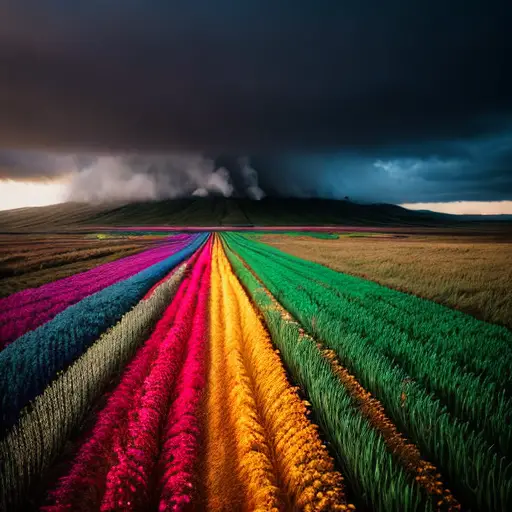Color Field Painting, my friends, is like a wild and vibrant explosion of hues on a canvas, leaving you wondering if a rainbow just had a psychedelic party. This artistic movement, which emerged in the 1950s and 1960s, aimed to strip away all the fuss and frills of traditional painting and focus solely on the power of color. Picture this: a canvas so vast and bold, it engulfs your entire field of vision, leaving you feeling like you've been swallowed by a kaleidoscope. Influenced by the abstract expressionists and their love for experimentation, Color Field painters sought to create an immersive experience, where color became the protagonist and brushstrokes took a backseat. So, forget about meticulously detailed landscapes or meticulously detailed anything, my friends, because in the world of Color Field Painting, it's all about letting the colors run wild and free!
Color field painting is a style of abstract art that emerged in the 1950s and 1960s, primarily in the United States. One interesting fact about color field painting is that it aimed to create a sense of vastness and expansiveness on the canvas by using large areas of flat color. Artists like Mark Rothko and Barnett Newman sought to evoke emotional and spiritual responses from viewers through the use of color, often creating immersive and meditative experiences. In fact, some viewers have reported feeling a sense of transcendence or even a loss of self when standing in front of these monumental color field paintings.
Let's dive into the mesmerizing world of Color Field Painting, where the canvas becomes a playground for colors to dance and sing. This technique, my fellow art enthusiasts, is all about creating large, flat expanses of color that seem to stretch beyond the boundaries of the canvas. No fussy details or intricate brushwork here, my friends. Instead, we find ourselves immersed in a sea of vibrant hues, where the colors have a life of their own. The artists behind this movement, inspired by the abstract expressionists, sought to evoke emotions and sensations through the sheer power of color. So, prepare to be captivated by the sheer simplicity and yet profound impact of Color Field Painting, where the canvas becomes a portal to a world where colors reign supreme.

In the vibrant realm of Color Field Painting, there were several pioneering artists who pushed the boundaries of this artistic movement and left an indelible mark on the art world. One such luminary was Mark Rothko, whose iconic rectangular canvases became synonymous with the genre. Rothko's genius lay in his ability to create an immersive experience through his use of color. His large, luminous fields of color seemed to envelop the viewer, evoking a sense of transcendence and introspection.
Another trailblazer in the world of Color Field Painting was Helen Frankenthaler. She developed a unique technique known as the 'soak-stain' method, where she poured diluted paint onto unprimed canvas, allowing the colors to blend and bleed into one another. This technique resulted in ethereal, dreamlike compositions that seemed to float effortlessly on the canvas. Frankenthaler's contributions to Color Field Painting were instrumental in expanding the possibilities of the medium and exploring the relationship between color and space.
Morris Louis, too, played a pivotal role in shaping Color Field Painting. He experimented with a technique called 'veil staining,' where he poured thinned acrylic paint onto unprimed canvas, allowing the colors to seep into the fabric. The result was a series of vibrant, translucent veils of color that seemed to hover weightlessly in space. Louis's innovative approach to color and his emphasis on the physicality of the paint itself challenged traditional notions of painting and paved the way for future generations of Color Field artists.
These pioneers, along with other notable figures like Barnett Newman and Clyfford Still, revolutionized the art world with their bold and audacious use of color. Through their contributions, Color Field Painting emerged as a powerful movement that celebrated the sheer beauty and emotive power of color. Their works continue to captivate audiences, inviting us to immerse ourselves in the mesmerizing world of color and experience the profound impact it can have on our senses and emotions.
Color field painting is a style of abstract art that emerged in the 1950s and 1960s, characterized by large areas of flat, solid color that cover the entire canvas. Fun fact: Some color field paintings are so large that they cannot fit through regular doorways, requiring them to be either created in the studio or transported through specially designed doors and windows!
The impact of Color Field Painting on contemporary art cannot be overstated. Its bold and immersive approach to color continues to resonate with artists today, inspiring new generations to explore the limitless possibilities of this medium. The legacy of Color Field Painting can be seen in the works of contemporary artists who embrace its principles, creating expansive canvases filled with vibrant, saturated hues. This movement has also influenced other artistic disciplines, such as installation art and digital media, where color is used to create immersive environments and evoke emotional responses. The lasting influence of Color Field Painting serves as a testament to the enduring power of color and its ability to transcend boundaries and connect with viewers on a deeply visceral level.